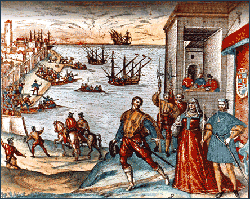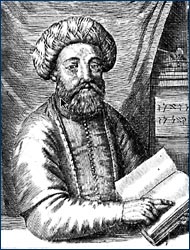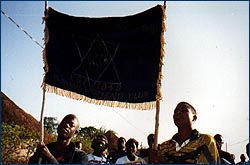
|

|
Where are the Ten Lost Tribes? Part 2 | Back to Part 1 Beyond the Sambatyon | Historical Introduction | Benjamin of Tudela New World Part I | New World Part II | The False Messiah | Tribal Groups Japan | Beta Israel-Ethiopia | Chiang-Min China
Boundless opportunity and fortune awaited Columbus and his crew as they set out on their voyage in 1492. The lands they discovered promised a new and better world. But for one Spanish missionary, the cruel enslavement and exploitation of the native Americans was not the picture of the New World he envisioned. In the early 16th century, Bartholeme de Las Casas became the champion of the Native American Indians, devoting his lifetime to improving the conditions—in the West Indies, Peru and Guatemala. Las Casas wrote: "These Indians can bring near the redemption. If we treat them humanely in this world and convert them to Christianity, we are preparing for the redemption of the Western world in the messianic era. Their conversion is apt indeed, as I am convinced the Indians originate in Ancient Israel. Indeed, I can bring proofs from the Bible that they are of the Lost Tribes." The association of the Indians with the Lost Tribes was heard again and again. The report by Portuguese traveler Antonio Montezinos some 120 years later aroused remarkable interest. "It was a thrilling journey I took in South America. Now that I am back in Amsterdam, I must share with you some incredible news. There is a Jewish Indian tribe living beyond the mountain passes of the Andes. Indeed, I myself heard them recite the She'ma (the expression of the Jewish faith) and saw them observe the Jewish rituals." Christian theologians awaiting the Second Coming were thrilled to receive this welcome news. For tradition held that when the Ten Tribes were found, reunited and restored to the Holy Land, the messianic age was close at hand.
Menasseh ben Israel, a Dutch Jewish scholar widely respected in both Christian and Jewish circles, played a central role in strengthening the association of the American Indians with the Lost Tribes. Deeply influenced by Montezinos' report and stimulated by his own mystical disposition, Ben Israel gradually fashioned his most important and best-selling book: The Hope of Israel. In 1655 Menasseh ben Israel met with Oliver Cromwell, Lord Protector of England, at Westminster. He dedicated The Hope of Israel to Parliament and submitted his petition for the recall of the Jews who had been expelled from England. Ben Israel's approach was shrewd indeed. He reiterated the belief that the dispersion of Jews to all corners of the Earth was the beginning of the redemption. The first stage had been realized—Israelite tribes had been discovered in the Americas! By completing the dispersion of the Jews, Cromwell himself could hasten the messianic era. He must readmit the Jews to England. Ben Israel associated the Hebrew word for "the end of the Earth" with the medieval term "Angle-Terre" or England. He wrote, "...All which things of necessity must be fulfilled, that so Israel at last being brought back, to his own place, peace which is promised under the Messiah may be restored to the world; and concord, which is the only Mother of all good things." These words echoed the hopes for a better world, awakened in the second half of the 18th Century during the American and French revolutions. Many abolitionists, for example, claimed that the Messianic Age would be ushered in when the slaves were freed and when the native Americans, descendants of the Ten Lost Tribes, were converted to Christianity. It would have given Menasseh Ben Israel considerable satisfaction to know how deeply his ideas had influenced social theory and the human rights movement.
In the year 1665, a fantastic manifesto made its way like lightning to all corners of the Islamic, Jewish and Christian worlds. Publicized by the charismatic rabbi, Nathan of Gaza, the letter announced that the Messiah had arrived: "Hear ye, brethren in Israel that our Messiah is come to life in the city of Ismir and his name is Shabbetai Zevi. Soon, he will show forth his kingdom to all and will take the royal crown from the head of the Sultan and place it on his own. When nine months have passed, our Messiah shall vanish from before the eyes of Israel, and no one should be able to say if he is alive or dead. He will cross the river Sambatyon, which as all men know no mortal has ever crossed. There, our Messiah shall ride forth through Jerusalem, with Moses and all the Jews of old mounted on horses. He himself shall ride on a dragon, and his bridle rein shall be a snake with seven heads. On his way, he will be attacked by Gog and Magog, the enemies of Israel, with a mighty arm. But the Messiah with the breath of his nostril shall he rout them, and by his word alone, shall he utterly destroy them. And when he is entered in Jerusalem, God will send down a temple of gold and precious stones from heaven, and it will fill the city with its brilliance. And on that day shall the dead throughout the world rise from their graves. I hasten to tell you these tidings." The news that the Messiah had arrived brought a wave of excitement in country after country. In a Messianic fervor, many Jews began to sell off their property and prepare for the trip to the Holy Land. Who was this so-called Messiah? His name was Shabbetai Zevi. He was born in Smirna in Asia Minor in 1626 and he was ordained as a rabbi when he was eighteen. Drawing upon the mystical teachings of the Kabbalah he proclaimed to the suffering Jewish world that redemption was at hand. His ideas reached Christians and Jews alike, in Morocco, Tunis, Egypt and Italy. Rumor was rampant that an army comprised of the lost tribes was marching up through Africa in the direction of Mecca. The Turkish authorities became concerned. In 1666, Shabbetai Zevi was arrested and not long after, he was converted to Islam. The story ends in bitter despair and disappointment. Following the example of their Messiah, thousands of Jews converted to Islam as well.
Straddling the boundaries between Afghanistan, Pakistan and Kashmir lives the world's largest tribal grouping—the Pathans. All of the 15 million Pathans, who comprise some 60 tribes, claim descent from Kish, an ancestor of the Biblical King Saul. Many of them also claim to be them children of the Lost Israelites. The Pathans perform circumcision of the eighth day, wear a fringed garment similar to the Jewish tzizit, light candles on Friday nights and observe food taboos similar to the laws of Kashrut. In South Africa, Zimbabwe and Mozambique, tens of thousands of blacks have, in recent years, declared themselves descendants of one of the Lost Tribes. The Lemba claim to have been cut off from mainstream Judaism hundreds of years ago. They are well-versed in the Old Testament and avoid marriage outside their community. From every imaginable corner of the world theories arise linking different peoples and tribes with the Ten Lost Tribes: the Crimea, the Caucasus, Kenya, Nigeria, Armenia, Persia, Central Asia, North Siberia, West Africa, Peru, South America, Australia, Ireland. While the evidence may at times seem flimsy, the Jewish elements in these tribal cultures continue to fascinate scholar and layman alike. Continue: Japan Where are the Ten Lost Tribes? | Tudor Parfitt's Remarkable Journey Mystery of Great Zimbabwe | Build a Family Tree | Resources Teacher's Guide | Transcript | Site Map | Lost Tribes of Israel Home Editor's Picks | Previous Sites | Join Us/E-mail | TV/Web Schedule About NOVA | Teachers | Site Map | Shop | Jobs | Search | To print PBS Online | NOVA Online | WGBH © | Updated November 2000 |
 Columbus departing on a voyage. Colored engraving,
16th century.
Columbus departing on a voyage. Colored engraving,
16th century.
 Native Americans from Peru.
Native Americans from Peru.
 A true portrait of Shabbetai Zevi, sketched by an
eyewitness in Smyrna, 1666.
A true portrait of Shabbetai Zevi, sketched by an
eyewitness in Smyrna, 1666.
 Members of the Lemba tribe.
Members of the Lemba tribe.